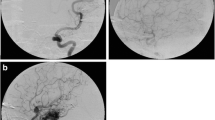Abstract
Arteriovenous malformation (AVM) may change the cerebral hemodynamics. The purpose of this study was to detect the effects of ionizing radiation (IR) on tissues surrounding AVM in a rat caroticojugular fistula model. Forty rats were divided into four groups. Eight weeks after caroticojugular fistulas and chronic hypoperfusion were created in groups 1 and 2, IR was administered to groups 1 and 3. Group 4 was the control. Brain tissue samples were taken 72 h after irradiation. Comet assay to detect DNA strand breaks (DSB), terminal deoxynucleotidyl transferase-mediated deoxyuridine triphosphate-biotin nick end labeling (TUNEL) assay for apoptosis, and free radical measurement were performed. Although the difference between fistula plus irradiation (group 1) and fistula (group 2) was statistically insignificant in terms of DSB and free radical measurement, apoptotic cell count was significantly higher in group 1. Nonetheless, apoptotic cell count corresponded well with both free radicals and DSB in the irradiated group (group 3). Ionizing radiation resulted in significant apoptosis in both groups with or without fistulas. Chronic hypoperfusion might not prevent cerebral damage after IR. Optimal care should be taken with brain tissue around AVM during radiotherapy, regardless of presence or absence of the “steal” phenomenon.




Similar content being viewed by others
References
Frankenberg-Schwager M (1990) Induction, repair and biological relevance of radiation-induced DNA lesions in eukaryotic cells. Radiat Environ Biophys 29:273–292
Lunec J (1990) Free radicals: their involvement in disease processes. Ann Clin Biochem 27:173–182
O’Neill P, Fielden EM (1993) Primary free radical processes in DNA. Adv Radiat Biol 17:53–120
Morgan MK, Anderson RE, Sundt TM Jr (1989) A model of the pathophysiology of cerebral arteriovenous malformations by a carotid-jugular fistula in the rat. Brain Res 496:241–250
Morgan MK, Anderson RE, Sundt TM Jr (1989) The effects of hyperventilation on cerebral blood flow in the rat with an open and closed carotid-jugular fistula. Neurosurgery 25:606–612
Irikura K, Morii S, Miyasaka Y, Yamada M, Tokiwa K, Yada K (1996) Impaired autoregulation in an experimental model of chronic cerebral hypoperfusion in rats. Stroke 27:1399–1404
Sekhon LHS, Morgan MK, Spence I, Weber NC (1997) Chronic cerebral hypoperfusion: pathological and behavioral consequences experimental study. Neurosurgery 40:548–556
Flickinger JC, Pollock BE, Kondziolka D, Lunsford LD (1996) A dose-response analysis of arteriovenous malformation obliteration after radiosurgery. Int J Radiat Oncol Biol Phys 36:873–879
Singh NP, McCoy MT, Tice RR, Schneider AA (1988) Simple technique for quantitation of low levels of DNA damage in individual cells. Exp Cell Res 175:184–191
Anderson D, Yu TW, Phillips BJ, Schmezer P (1994) The effects of various antioxidants and other modifying agents on oxygen-radical generated DNA damage in human lymphocytes in the COMET assay. Mutat Res 307:261–271
Sgonc R, Boeck G, Dietrich H, Gruber J, Recheis H, Wick G (1994) Simultaneous determination of cell surface antigens and apoptosis. Trends Genet 10:41–42
Draper HH, Hadley M (1990) Malondialdehyde determination as index of lipid peroxidation. Methods Enzymol 186:421–431
Batjer HH, Devous GB Sr, Seibert B, Purdy PD, Ajmani AK, Delarosa M, Bonte FJ (1988) Intracranial arteriovenous malformation: relationships between clinical and radiographic factors and ipsilateral steal severity. Neurosurgery 23:322–328
Bennett SA, Tenniswood M, Chen JH, Davidson CM, Keyes MT, Fortin T, Pappas BA (1998) Chronic cerebral hypoperfusion elicits neuronal apoptosis and behavioral impairment. Neuroreport 9:161–166
Jin K, Chen J, Nagayama T, Chen M, Sinclair J, Graham SH, Simon RP (1999) In situ detection of neuronal DNA strand breaks using the Klenow fragment of DNA polymerase I reveals different mechanisms of neuron death after global cerebral ischemia. J Neurochem 72:1204–1214
Fairbairn DW, Olive PL, O’Neill KL (1995) The comet assay: a comprehensive review. Mutat Res 339:37–59
Olive PL (1998) The role of DNA single- and double-strand breaks in cell killing by ionizing radiation. Radiat Res 150 [Suppl]:S42–S51
Chapman JD, Reuvers AP, Borsa J, Greenstock CL (1973) Chemical radioprotection and radiosensitization of mammalian cells growing in vitro. Radiat Res 56:291–306
Greenstock CL (1984) Free-radical processes in radiation and chemical carcinogenesis. Adv Radiobiol 11:269–293
Skov KA (1984) The contribution of hydroxyl radical to radiosensitization: a study of DNA damage. Radiat Res 99:502–510
Esterbauer H, Schaur RJ, Zollner H (1991) Chemistry and biochemistry of 4-hydroxynonenal, malonaldehyde and related aldehydes. Free Radic Biol Med 11:81–128
Harms-Ringdahl M, Nicotera P, Radford IR (1996) Radiation induced apoptosis. Mutat Res 366:171–179
Nornes H, Grip A (1980) Hemodynamic aspects of cerebral arteriovenous malformations. J Neurosurg 53:456–464
Feindel W, Perot P (1965) Red cerebral veins. A report on arteriovenous shunts in tumors and cerebral scars. J Neurosurg 22:315–325
Feindel W, Yamamoto L, Hodge CP (1971) Red cerebral veins and the cerebral steal syndrome. J Neurosurg 35:167–176
Altschuler E, Lunsford D, Kondziolka D, Wu A, Maitz AH, Sclabassi R, Martinez AJ, Flickinger JC (1992) Radiobiologic models for radiosurgery. Neurosurg Clin North Am 3:61–77
Szumiel I (1994) Ionizing radiation-induced cell death. Int J Radiat Biol 66:329–341
Acknowledgements
This study was supported by a grant from Hacettepe University School of Medicine. The authors would like to thank Prof. Dr. Kamer Kilinc for free radical measurements, Prof. Dr. Ersin Tan and Nursen Basaran, PhD for providing their laboratories, Ilker Etikan, PhD for statistical analysis, Bulent Cakir, Bulent Yapici, and Salih Gurdalli for their excellent technical assistance, and Lisa Foster for her editing of the manuscript.
Author information
Authors and Affiliations
Corresponding author
Rights and permissions
About this article
Cite this article
Mut, M., Öge, K., Zorlu, F. et al. Effects of ionizing radiation on brain tissue surrounding arteriovenous malformations: an experimental study in a rat caroticojugular fistula model. Neurosurg Rev 27, 121–127 (2004). https://doi.org/10.1007/s10143-003-0316-3
Received:
Revised:
Accepted:
Published:
Issue Date:
DOI: https://doi.org/10.1007/s10143-003-0316-3




